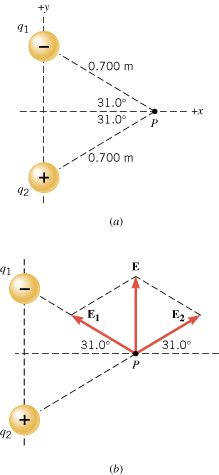Two point charges are lying on the y axis in Figure 18.41a: q1![]() =
=![]() –4.00 mC and q2
–4.00 mC and q2![]() =
=![]() +4.00 mC. They are equidistant from the point P, which lies on the x axis. (a) What is the net electric field at P? (b) A small object of charge q0
+4.00 mC. They are equidistant from the point P, which lies on the x axis. (a) What is the net electric field at P? (b) A small object of charge q0![]() =
=![]() +8.00 mC and mass m
+8.00 mC and mass m![]() =
=![]() 1.20 g is placed at P. When it is released, what is its acceleration?
1.20 g is placed at P. When it is released, what is its acceleration?
 |
|
There is no charge at P in part (a). Is there an electric field at P?
Yes. An electric field is produced by the charges q1 and q2, and it exists throughout the entire region that surrounds them. If a test charge were placed at this point, it would experience a force due to the electric field. The force would be the product of the charge and the electric field.The charge q1 produces an electric field at the point P. What is the direction of this field?
The electric field created by a charge always points away from a positive charge and toward a negative charge. Since q1 is negative, the electric field E1 points toward it (see Figure 18.41b).What is the direction of the electric field produced by q2 at P?
Since q2 is positive, the electric field E2 that it produces points away from q2, as shown in the drawing.Is the magnitude of the net electric field equal to E1![]() +
+![]() E2, where E1 and E2 are the magnitudes of the electric fields produced by q1 and q2?
E2, where E1 and E2 are the magnitudes of the electric fields produced by q1 and q2?
Solution








